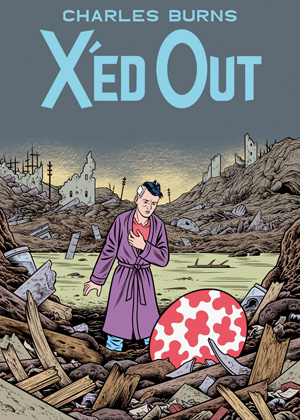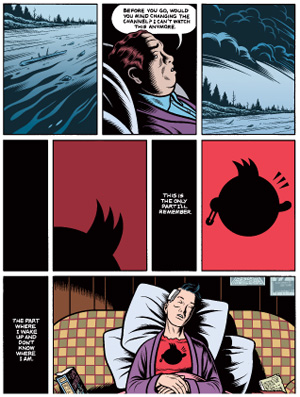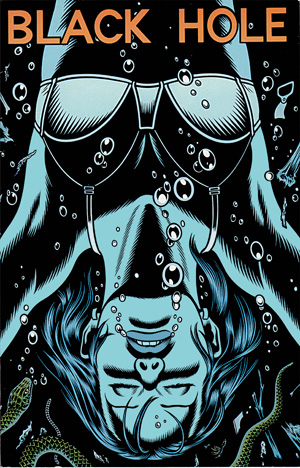
HALLOWEEN comes early this year with the release of X’ed Out, a new book by Charles Burns. Many phantoms stalk this work—and one of the most unquiet is the ghost of punk rock.
Burns is a nationally known illustrator and the staff artist at literary magazine The Believer. The formative time he spent in a Central California art school contributes to X’ed Out. The book is an emotion-laden dream journey that takes Burns’ bifurcated characters into a disturbing foreign realm; in a reverse angle, Burns also shows us a young artist’s odyssey through a realistically rendered bad part of town in the 1970s.
Some of the most distinguished cartoonists have drawn horror stories, but in our time Burns is the most shockingly elegant of them all. X’ed Out (Pantheon; $19.95 hardback), which will be continued in two subsequent volumes, represents some of his most visually mesmerizing and handsomely presented work.
X’ed Out constitutes a new triumph for the cartoonist best known for his series Black Hole, which is awaiting adaptation into a film. Burns, calling from his Philadelphia home, says of the project, “I think the last I heard is that things are still moving forward, and as far as I know there’s a script and David Fincher is still attached as a producer—they’re still looking for directors.”
X’ed Out takes place in two dimensions with a shaky barrier between them. In a basement, Nitnit, a shock-haired figure, wakes up on his folding couch bed. Inky, a long-lost cat (“God, I … I thought you were dead”) leads Nitnit through an aperture in a brick wall into a parallel world in ruins: there are collapsed tombs and green swamps where piggish humanoids float. The wanderer passes an incubation room full of enormous eggs with scarlet blotches, tended by furious man-sized salamanders.
The trek continues into a threatening foreign setting, where diseased merchants sell repulsive, living food. Nitnit is aided by a sinister, swollen half-pint in a dhoti. Unbidden come visions of an ailing, depressed father, who is giving up his life to booze, TV and cigarettes, his skin jaundiced to a pale urine color.
Perhaps this is all the dream of Doug, a lay-about of the late 1970s, very ill himself. Doug’s half-shaven head is bandaged, and he depends on a dwindling supply of some increasingly ineffective medicine.
Doug’s fevered mind flashes back to a time when he had his health, when he was an aspiring performance artist wearing a Nitnit mask, reading from his dream journal at an underground galley. There, Doug meets Sarah, a girl who poses for troubling photos. She herself is stalked by a raging ex-boyfriend who has already started destroying her possessions.
Those familiar with Burns can guess how smooth-looking such a jagged-sounding trip is. The book is laid out in primarily nine-panel pages. The foreground characters are drawn in that so-called ligne claire style popular in Low Country cartoonists, particularly the best known of them all, Hergé, creator of Tintin.
The rest of the art is unmistakably Burns: flat panels of color or pulsating squares that look like dark-field microscopy. Placid skin gives up jagged wounds; the eye is assaulted by suppurating masses of flesh and oozing meat or blasted rocks and swamps and flotsam. Throughout X’ed Out runs that most elemental discontent: an atmosphere of being in the center of a crowd of people who want to do you harm.
Funk Figures
Burns grew up in various places across the country. A childhood touchstone, often referred to in interviews, is his fascination with The Outer Limits, a popular 1960s TV sci-fi anthology show with regular parables of strange invaders. Its adventures forecast the stories of Burns’ odd child character Big Baby.
David Lynch’s name gets dropped by critics who read Black Hole, which was serially published between 1995 and 2005, and then collected in book form. As one of those critics, I described Black Hole‘s setting as a Cobainian northwestern landscape, circa 1975.
An unnamable plague strikes the young on the fringes of a Seattle suburb, the result of a degenerative disease carried by sex and shared saliva. A circle of seemingly harmless “freaks”—as vegetating drug-takers of the time proudly called themselves—are genuine mutants. But the worst creature lurking about is only glimpsed, not fully seen. Black Hole displays Burns’ usual blend of fantastic monstrosity with almost photorealistic high-contrast black-and-white figures and faces.
The originality of the tale is rooted in the unbearably sharp feelings of adolescence. Seascape raptures are ruined by turds, bones, litter and broken glass. Vertiginous circles and jagged rents tear open the fabric of the ordinary world. But maybe the worst damage is caused by the adolescent delusion that a lover is actually a messiah.
Black Hole alludes to the shame of adolescence—a chemical change that turns an unwitting child into a stranger to himself. This is also Lynch’s theme in Blue Velvet and the real story of the demon-haunted Washington woods in Twin Peaks. Both artists came from the Pacific Northwest; Lynch from Idaho, Burns from Washington state (as well as Washington, D.C.).
“I moved around a lot but Seattle was my home base, that’s where I spent the most important part of my childhood,” Burns says.
Lynch and Burns also both lived in Philadelphia. “Lynch is on record saying he’d never live in Philadelphia again,” Burns replies. “But I like big decaying cities.”
The use of dreamlike narratives seems to link the two artists. I asked if Burns had much of a dream life: “As much as anyone else. Unlike my characters, I don’t find my way into other people’s heads. I pay attention to my subconscious as a source for the storytelling. The comics are a method to investigate dreams I’ve had.”
Ultimately, however, Lynch’s and Burns’ sensibilities differ. Burns, for example, uses a form of out-and-out humor that isn’t found in Lynch. Where Lynch is the kind of artist who could turn up for years at the same coffee shop, Burns is more of a wanderer. Burns’ schooling was varied, and it included a stint in art school at UC-Davis during the peak of the funk-art years.
Funk art was a ’70s post-Pop movement based on salvaged or untraditional materials, on deep veins of humor and political content: its ecstasies countered the austere minimalism then popular in New York. Nearby in Winters, Calif., Robert Crumb was doing the best work of his career. Among many activities in the 1970s, Crumb drew for and edited Weirdo magazine, a conduit between the smartest of the hippie cartoonists and the most astute of the punks.
Later, Crumb’s praises appear on the back cover of X’ed Out: “”It’s almost as if the artist … as if he weren’t human!”
Burns would come to worldwide attention at a magazine that was diametrically opposite of Weirdo: Art Spiegelman’s New York–based Raw was an attempt to create the kind of high-art presentation the comic book was getting in Western Europe. Designing the cover for Raw and appearing in several issues, Burns became one of its most noteworthy artists.
All this came later. At Davis, Burns was one of the first Anglos to admire lucha libre culture, whence he sourced his character themasked-wrestling detective El Borbah. “There’s a lot of little towns around Davis that would have Mexican magazines with wrestlers on the cover,” Burns recalls. “I found myself interested in that look and these almost ridiculously fun costumes. I was especially struck by one who would dress in a black suit and tie and carry a brief case—a wrestler who is an executive, who comes off like a lawyer!”
At UC-Davis, Burns studied a series of different disciplines: “I was learning photography and drawing and painting and sculpture. But a lot of my drawing had this narrative feel. I wasn’t really doing a lot of comics per se—right during the end of my time there, I started doing a photo comic based on the fotonovelas in Mexican magazines I’d seen.
“It got me into thinking about wanting to do comics, to tell a narrative for mass circulation. I thought, you could put two weeks on a drawing and sell it and never see it again. Or you could work for publication. If five people wanted to read it, that’d be great. If 50,000 people wanted to read it, that’d be even better.”
Burns also attended Evergreen State in Washington for a time, where notable alternative cartoonists Matt Groening and Lynda Barry were students. “Matt was editing the Cooper Point Journal, the school paper; I worked there for a year, laying out adds, doing paste-up and writing comics.”
That ’70s Show
Burns has never been an artist who fancied direct autobiography, but the passages of X’ed Out regarding punk rock in the late 1970s are as evocative as the stories of teen rejects in the woods in Black Hole.
Even the title of the book itself has that tell-tale X. It’s a tremendously symbolic letter for punks, the letter of secrets, of the unknown. It is the letter of negation: a double pen slash through the glossy face of a poster or a billboard. There was, of course, Geza X, Billy Idol’s Generation X and that certain husband-and-wife band from L.A. If punk was a movement that chose exile, it also made a home for exiles.
“It was liberating, that period,” Burns says. “I lived through it, and a portion of it has stuck with me. What I liked is the idea of taking responsibility for your own work. If tomorrow comes, and my books don’t sell, I’ll still do comics, even if they’re Xeroxed photocopies. At this point in my career, I have control. No one at Pantheon explained to me what kind of project I should be doing or how I could make it a corporate project. I finished my book and showed it to them, and all that got changed was some spelling and punctuation. It’s even the case that I’ve learned the skills of how to scan the work to computer and do the colors digitally … with some help from friends to make sure it’s done properly.”
Burns’ graphic punch derives from his evocative use of black and white. “I have a fair sense of color,” he says, “and I wanted to make sure I was avoiding coming up with a colorized version of black and white. Obviously, part of what I wanted to do was a book in the style and that format of the French/Belgian comic-book album, a style commonplace over there, if not here.”
X’ed Out‘s cover is a tribute to Hergé’s 1942 Tintin adventure L’Etoile Mystérieuse, called in English The Shooting Star, depicting our journalist hero flabbergasted by a 15-foot-tall mushroom. And of course, the shock-haired dream figure “Nitnit” is about as cleverly disguised as a”Count Alucard” ever was in a horror movie. That goes double for Nitnit’s pet Inky the Cat, standing in for Snowy the Dog.
But the nightmare landscape is almost like Tintin’s Naked Lunch; as if Burns had sent the Belgian boy reporter to William S. Burrough’s “The Zone” just as modern artists send characters to Alice’s Wonderland or Dorothy’s Oz.
“Certainly,” Burns comments, “that influence comes from that period in which the core of the story takes place, the 1970s. Burroughs fit into that world, that dispossessed youth culture, fed up with post-hippie fake idealism. In Burroughs, there always was this polarity of disgust and fascination. His dark vision of the world was something I related to.”
The passage where Doug, wearing a Nitnit mask, performs a staged reading of “cut-ups” of the Burroughs/Brion Gyson school was indeed something Burns did when he was a student in the 1970s. “There’s no documentation, thank God,” Burns says. “There’s some half-inch reel-to-reel videotape of the performance, but it hasn’t seen the light of day. I wasn’t like the character Doug in every way, just in some ways. He reflects what I was doing at school.”
Ultimately, even punk proved to be a temporary way station for Burns, and X’ed Out may well be his elegy for it. The story is told elsewhere in memoirs of those on the scene, but as the artist says, “I was just talking to Gary Panter [a fellow artist at Raw] who was the first person who I’d ever had a sense of being a punk cartoonist because he worked at Slash magazine. He was saying that the early days of punk were mostly girls and very wimpy art students. They were the kids who got their asses kicked at school … but then before long, the surf punks descended into the mosh pit.” When the bruisers crashed the dance floor, punk was all ready for commodification.
X’ed Out immerses us in a nightmare vision, but there’s a kind of paradise that complements its inferno. And that’s what draws me in: the moments of youthful happiness. Burns is trying to reclaim the earlier sense of possibilities of punk: “the goofy art student feel. Culture wasn’t defined yet at this stage; maybe some people had seen some English magazines, they’re wearing something they’ve seen the Sex Pistols wear, and they still don’t know you don’t have to draw swastikas on your arms. Maybe they’ve still got long hair to go with the skinny tie.
“Once in the fall of 1977, this girl on the street passed me; she was wearing a crooked pair of plastic sunglasses and she stopped to ask me, “Do I look punk?” There’s a certain sadness to that kind of behavior—I may put it in the next comic.”
Charles Burns appears Tuesday (Oct. 26) noon–2pm at Lee’s Comic, 1020F N. Rengstorff Ave., Mountain View, and at 7:30pm at Bookshop Santa Cruz. Free.




